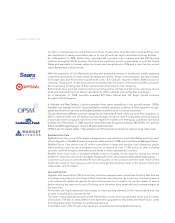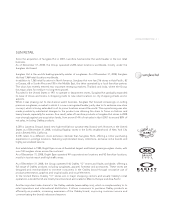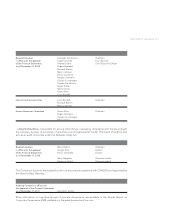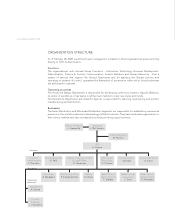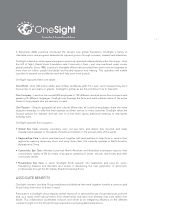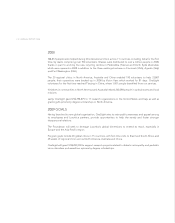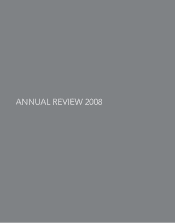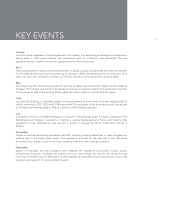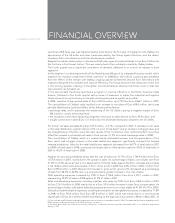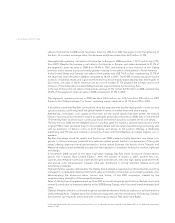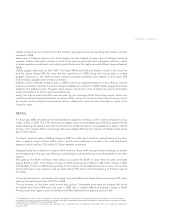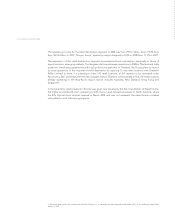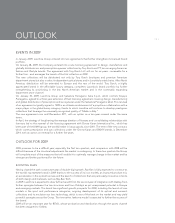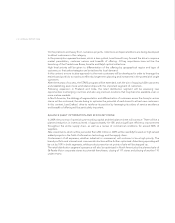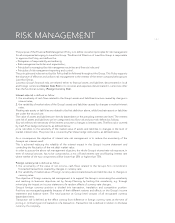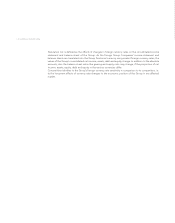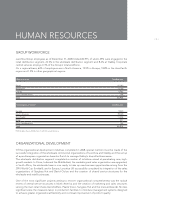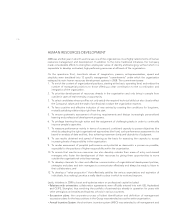LensCrafters 2008 Annual Report Download - page 38
Download and view the complete annual report
Please find page 38 of the 2008 LensCrafters annual report below. You can navigate through the pages in the report by either clicking on the pages listed below, or by using the keyword search tool below to find specific information within the annual report.
> 36 |ANNUAL REPORT 2008
Luxottica’s 2008 fiscal year was characterized by three factors: the first year of integration with Oakley, the
depreciation of the US dollar and other currencies used by the Group against the Euro, and the drastic
slowdown first in the American and then the European markets.
Despite the sudden deterioration in the second half, sales grew at sustained levels to top Euro 5 billion for
the first time in the Group’s history. This was mainly due to the contribution made by Oakley’s sales.
The fourth quarter saw a significant contraction of demand, reflected in an erosion of margins in both
segments.
In this situation, Luxottica reacted with all the flexibility and efficacy of its integrated business model, which
enabled it to maintain a high level of free cash flow(1) in 2008 (Euro 302 million). Luxottica also benefited
from the effects of the merger with Oakley, ongoing capital investments (around Euro 300 million) and
measures designed to boost sales and improve efficiency. The Group expects these measures to bear fruit
in the coming quarters, helping to strengthen Luxottica’s balance sheet and optimize costs so that new
opportunities can be taken up.
In the second half, the Group launched a program to improve efficiency in the North American retail
division, followed in the fourth quarter with a series of measures to adjust the industrial and logistics
infrastructure to bring the Group in line with shrinking demand as quickly as possible.
In 2008, Luxottica Group posted sales of Euro 5,201.6 million, up 4.7% from Euro 4,966.1 million in 2007.
The consolidation of Oakley’s sales resulted in an increase to net sales of Euro 638.4 million, which was
partially offset by the combined effect of the following three factors:
•exchange rates, and in particular the weakening of the US dollar, causing a negative impact of Euro
294.2 million, mostly at the retail level;
•the slowdown in the retail distribution segment, which saw its sales decline by Euro 95.9 million; and
•a slight contraction in sales (Euro 12.7 million) by the wholesale distribution segment, net of Oakley.
Pro forma(2) net sales decreased by Euro 337.4 million, or 6.1%, compared to 2007. A decrease in net sales
in the retail distribution segment (down 2.1% on a pro forma basis(2) and at constant exchange rates) and
the strengthening of the Euro were the main causes of this contraction: their combined effect more than
offset the increase in wholesale net sales to third parties (+1.3% at constant exchange rates in 2008).
The consolidation of Oakley, which is a predominantly wholesale business, and the appreciation of the
Euro, which had a bigger impact on the retail distribution segment, significantly changed the Group’s
revenue breakdown. Sales for the retail distribution segment decreased from 65.7% of total sales in 2007
to 59.8% of total sales in 2008; conversely, wholesale sales to third parties rose from 34.3% of total sales in
2007 to 40.2% of total sales in 2008.
Analysis of costs and profitability shows that the cost of sales rose 10.7% to Euro 1,744.9 million from Euro
1,575.6 million in 2007, mainly due to the growth in sales. As a percentage of sales, cost of sales rose from
31.7% to 33.5%, above all due to the depreciation of the US dollar against the Euro: net sales are primarily
in US dollars, while costs are primarily in Euro. Gross profit in 2008 rose 2.0% to Euro 3,456.7 million from
Euro 3,390.4 million in 2007. Despite the increase in gross profit, gross profit decreased as a percentage
of sales from 68.3% to 66.5%, due to a proportionately greater increase in the cost of sales.
Total operating expenses increased by 5.9% to Euro 2,706.9 million from Euro 2,557.1 million in 2007,
representing 52.0% of sales in 2008 against 51.5% of sales in 2007.
Sales and advertising expenses, including royalties, also grew, by 4.5%, from Euro 2,069.3 million in 2007
to Euro 2,161.4 million in 2008, mainly due to a Euro 53.9 million increase in sales force compensation. As
a percentage of sales, selling and advertising expenses were more or less stable at 41.5% (41.7% in 2007).
General and administrative expenses, including amortization of intangible fixed assets, increased by 11.8%
in 2008, to Euro 545.6 million from Euro 487.8 million in 2007, which was mainly due to a non-recurring
capital gain of Euro 20.0 million (before tax) relating to the disposal of a property in Milan in May 2007, an
FINANCIAL OVERVIEW
(1) Free cash flow and EPS before trademark amortization are not measures in accordance with US GAAP. For additional disclosures regarding non-US
GAAP measures and a reconciliation to US GAAP measures, see Annex.
(2) Pro forma data reflects the inclusion of results by Oakley, Inc., a subsidiary that was acquired in November 2007, as if it had been acquired on
January 1, 2007.


